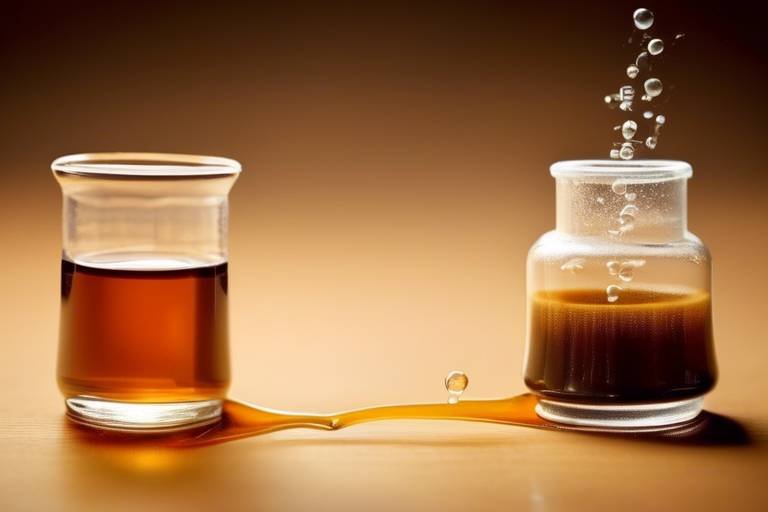The Chemistry of Cleaning Agents - Safe Alternatives
In today's world, where cleanliness is paramount, understanding the chemistry of cleaning agents is more important than ever. Many of us reach for commercial cleaners without a second thought, but do we really know what's in them? This article will explore the various cleaning agents available, their chemical compositions, and highlight safe alternatives that are effective for household cleaning while being environmentally friendly. By the end of this journey, you'll not only know what you’re using to clean your home but also how to make safer choices for you and the planet.
Cleaning agents are substances designed to remove dirt, stains, and impurities from surfaces. They come in various forms, including liquids, powders, and sprays, each tailored for specific cleaning tasks. The main function of these agents is to break down the bonds between dirt and the surface, allowing for easy removal. But how do they actually work? When you apply a cleaning agent, it interacts with different surfaces and materials through a combination of physical and chemical processes. This interaction can be likened to a dance, where the cleaning agent partners with the dirt, loosening its grip and making it easier to wipe away.
Many cleaning products contain harsh chemicals that can pose risks to both health and the environment. For instance, substances like bleach and ammonia are often found in household cleaners, and while they may be effective at killing germs, they can also lead to respiratory issues and skin irritation. Furthermore, these chemicals can have detrimental effects on aquatic ecosystems when they enter our water systems. Understanding the most common ingredients in these products is crucial for making informed decisions about what we bring into our homes.
One of the key players in the world of cleaning agents is surfactants. These compounds reduce surface tension, allowing water to spread and penetrate more effectively. Think of surfactants as the friendly negotiators in a tense situation—they help water mingle with oil and dirt, breaking them down so they can be washed away. Surfactants are essential in various cleaning applications, from laundry detergents to dish soaps, helping to lift stains and grime off surfaces.
Surfactants can be categorized into three main types: anionic, cationic, and nonionic. Each type has its unique properties and uses:
| Type | Characteristics | Common Uses |
|---|---|---|
| Anionic | Negatively charged, effective at removing dirt and stains | Laundry detergents, dishwashing liquids |
| Cationic | Positively charged, effective against bacteria | Fabric softeners, disinfectants |
| Nonionic | Neutral charge, less sensitive to water hardness | All-purpose cleaners, glass cleaners |
While surfactants are effective, their use can significantly impact aquatic ecosystems. Many surfactants do not break down easily in nature, leading to pollution and harm to aquatic life. When these chemicals enter water bodies, they can disrupt the natural balance, harming fish and other organisms. It’s crucial to consider the environmental implications of our cleaning choices, as every little action contributes to a larger impact.
Solvents are another category of cleaning agents that play a vital role in dissolving dirt and grease. These substances help break down tough stains, making them easier to remove. Common solvents include alcohol, acetone, and mineral spirits. However, while they can be highly effective, many solvents are also volatile organic compounds (VOCs), which can release harmful fumes into the air. This is why opting for safer alternatives is becoming increasingly important.
Fortunately, there are many safe alternatives that can replace traditional cleaning agents without compromising on effectiveness. Natural ingredients not only clean well but also come with fewer health risks. By using items you likely already have at home, you can create effective cleaning solutions that are gentle on both your family and the planet.
Two of the most versatile cleaning agents are vinegar and baking soda. These household staples have powerful cleaning properties that can tackle a wide range of tasks. For instance, vinegar can break down mineral deposits and deodorize surfaces, while baking soda acts as a gentle abrasive, perfect for scrubbing. Together, they can create a fizzing reaction that can lift grime effortlessly. To use them effectively, simply mix equal parts vinegar and water in a spray bottle for an all-purpose cleaner, or sprinkle baking soda on surfaces before spraying with vinegar for a deep clean.
Not only do essential oils provide pleasant scents, but many also possess antimicrobial properties. Oils like tea tree, lavender, and lemon can enhance your homemade cleaning solutions, making them not only effective but also enjoyable to use. For example, adding a few drops of tea tree oil to your vinegar solution can boost its germ-fighting capabilities. Plus, the delightful aroma can make cleaning feel less like a chore and more like a spa day!
1. Are natural cleaning agents as effective as chemical ones?
Yes! Natural cleaning agents like vinegar and baking soda can be very effective at removing dirt and grime, often with fewer health risks.
2. Can I use essential oils in all my cleaning solutions?
While most essential oils are safe for cleaning, it’s best to check if they are suitable for the specific surfaces you are cleaning.
3. How can I make my own cleaning products at home?
You can easily make your own cleaning products using common household ingredients like vinegar, baking soda, and essential oils. There are many recipes available online!

Understanding Cleaning Agents
This article explores various cleaning agents, their chemical compositions, and highlights safe alternatives that are effective for household cleaning while being environmentally friendly.
Cleaning agents are the unsung heroes of our homes, tirelessly working behind the scenes to keep our living spaces spotless and inviting. These substances, often referred to as detergents or cleaners, are designed to remove dirt, stains, and impurities from various surfaces. But what exactly are cleaning agents, and how do they work their magic? In essence, they are formulated to interact with different materials, breaking down grime and leaving surfaces gleaming.
At their core, cleaning agents can be categorized into several types based on their functions and chemical compositions. Some of the most common types include:
- Surfactants: These are compounds that lower the surface tension of water, allowing it to spread and penetrate more effectively. Surfactants are essential for emulsifying oils and suspending dirt.
- Solvents: These agents dissolve dirt and grease, making them easier to remove. They are particularly effective on oily stains and residues.
- Acids and Bases: Many cleaning agents have acidic or alkaline properties, which help break down mineral deposits, soap scum, and other stubborn stains.
Understanding how these cleaning agents interact with different surfaces is crucial for effective cleaning. For instance, using an acidic cleaner on a marble surface can lead to etching and damage, while a gentle surfactant might be perfect for delicate fabrics. This knowledge empowers us to choose the right product for the job, ensuring that we maintain our belongings while achieving the cleanliness we desire.
Moreover, the effectiveness of a cleaning agent often depends on its concentration and the method of application. For example, using a concentrated solution might yield better results, but it also requires careful handling to avoid damage or harmful reactions. It's a delicate balance between achieving cleanliness and maintaining safety.
In summary, cleaning agents are essential tools in our daily lives, each with unique properties and applications. By understanding their functions and interactions with various materials, we can make informed choices that not only enhance our cleaning routines but also promote a healthier, safer environment for ourselves and our families.
Many cleaning products contain harsh chemicals. Here, we delve into the most common ingredients found in commercial cleaners and their potential health and environmental impacts.
Surfactants play a crucial role in cleaning by reducing surface tension. This subsection explains how surfactants work and their effectiveness in various cleaning applications.
There are several types of surfactants, including anionic, cationic, and nonionic. This section compares their properties and uses in cleaning products.
The use of surfactants can affect aquatic ecosystems. We explore how these chemicals break down and their implications for water quality.
Solvents help dissolve dirt and grease. This subsection discusses the different types of solvents used in cleaning agents and their effectiveness.
Many safe alternatives can replace traditional cleaning agents. This section highlights natural ingredients that are effective for cleaning without harmful side effects.
Vinegar and baking soda are versatile cleaning agents. This subsection explains their cleaning properties and how to use them effectively in various household tasks.
Essential oils not only provide pleasant scents but also possess antimicrobial properties. This section discusses popular essential oils and their uses in homemade cleaning solutions.
Q: Are all cleaning agents harmful to the environment?
A: Not all cleaning agents are harmful. Many natural alternatives, like vinegar and baking soda, are environmentally friendly and effective.
Q: How can I make my own cleaning solutions?
A: You can create effective cleaning solutions using common household ingredients like vinegar, baking soda, and essential oils. For example, mixing vinegar with water can create a great all-purpose cleaner.
Q: What are surfactants, and why are they important?
A: Surfactants are compounds that lower the surface tension of liquids, making them effective at breaking down dirt and grease. They are crucial in many cleaning products for their ability to enhance cleaning performance.

Common Chemical Ingredients
When it comes to cleaning our homes, many of us reach for commercial cleaning products without giving much thought to their ingredients. However, understanding the common chemical ingredients in these products is crucial, not just for our health but also for the environment. A surprising number of cleaning agents contain harsh chemicals that can have adverse effects on our health and the planet. In this section, we will delve into the most prevalent ingredients found in household cleaners, exploring their functions, potential risks, and how they interact with our living spaces.
One of the most common categories of ingredients in cleaning products is surfactants. These compounds are designed to lower the surface tension of water, allowing it to spread and penetrate more effectively. Surfactants are often derived from both natural and synthetic sources, and while they are effective at removing dirt and grease, they can also pose environmental concerns. For instance, certain surfactants can be toxic to aquatic life when they enter waterways. This raises an important question: are we sacrificing our health and the health of our ecosystems for a cleaner home?
Another category that warrants attention is solvents. Solvents are used to dissolve dirt, grease, and other unwanted substances. They can be effective at cutting through tough stains, but many commercial solvents are derived from petroleum-based sources, which can release harmful volatile organic compounds (VOCs) into the air. These compounds not only contribute to air pollution but can also lead to respiratory issues in humans. It's essential to consider whether the short-term benefits of these products outweigh their long-term impacts on our health.
| Ingredient | Function | Potential Risks |
|---|---|---|
| Surfactants | Reduce surface tension for better cleaning | Toxic to aquatic life, skin irritant |
| Solvents | Dissolve grease and stains | Release VOCs, respiratory issues |
| Fragrances | Add pleasant scent | Allergic reactions, hormone disruption |
| Bleach | Whiten and disinfect | Corrosive, respiratory irritant |
Additionally, many cleaning products contain fragrances, which are often a mixture of various chemicals. While they may leave your home smelling fresh, they can also trigger allergic reactions and even disrupt hormones. It's ironic that we seek to create a pleasant environment while potentially introducing harmful substances into our homes.
Lastly, bleach is a widely used ingredient known for its disinfecting properties. While it can effectively kill germs, it is also a corrosive substance that can irritate the skin and respiratory system. The fumes from bleach can be particularly harmful when mixed with other common household chemicals, leading to dangerous reactions. So, before you pour that bleach into your cleaning bucket, ask yourself: is it worth the risk?
In conclusion, being aware of the common chemical ingredients in cleaning products can empower us to make better choices for our health and the environment. By opting for safer alternatives, we not only protect ourselves but also contribute to a cleaner planet. In the next section, we will explore some of these safe alternatives that can effectively replace conventional cleaners without the harmful side effects.
- What are surfactants? Surfactants are compounds that lower the surface tension of water, making it easier to clean surfaces.
- Are all cleaning products harmful? Not all cleaning products are harmful, but many commercial cleaners contain ingredients that can pose health and environmental risks.
- What are some safe alternatives to conventional cleaners? Natural ingredients like vinegar, baking soda, and essential oils can be effective and safe alternatives.
- How can I find out what's in my cleaning products? You can check the product label for ingredients or visit the manufacturer's website for detailed information.

Surfactants
Surfactants, or surface-active agents, are the unsung heroes of the cleaning world. They work diligently behind the scenes, playing a crucial role in breaking down dirt and grime. But how do they actually do this? Imagine trying to wash a greasy plate with just water—frustrating, right? This is where surfactants come into play. They reduce the surface tension of water, allowing it to spread and penetrate more effectively. This means that when you use a cleaner containing surfactants, you're not just wiping at the surface; you're actively lifting and removing the dirt from the material.
Surfactants can be categorized into three main types: anionic, cationic, and nonionic. Each of these types has unique properties that make them suitable for different cleaning applications. For instance, anionic surfactants are excellent at removing dirt and stains, making them a popular choice in laundry detergents and dish soaps. On the other hand, cationic surfactants are often used for their antibacterial properties, commonly found in fabric softeners and disinfectants. Nonionic surfactants, with their gentle nature, are typically used in products designed for sensitive surfaces, such as glass cleaners.
While surfactants are effective, it's essential to consider their environmental impact. Many commercial cleaning products contain synthetic surfactants that can be harmful to aquatic ecosystems. When these products are washed down the drain, they can disrupt the natural balance of water bodies, affecting fish and other aquatic life. As they break down, they may release toxins that further harm the environment. This raises the question: is it possible to achieve effective cleaning without compromising our ecosystems? The answer is a resounding yes!
In fact, there are eco-friendly surfactants derived from natural sources, such as plant oils, that can effectively clean without the negative side effects. These alternatives are not only better for the environment but also safe for our health. Imagine cleaning your home with products that are both effective and gentle on the planet—sounds like a win-win, right? By choosing safer surfactants, we can enjoy a cleaner home while protecting the earth for future generations.
To summarize, surfactants are vital in the cleaning process, helping to lift and remove dirt effectively. However, the choice of surfactant matters. Opting for natural and eco-friendly alternatives can make a significant difference in reducing our environmental footprint. So, next time you're cleaning, consider the surfactants in your products and their impact on both your home and the planet.

Types of Surfactants
Surfactants, or surface-active agents, are the unsung heroes of the cleaning world. They are categorized into three main types: anionic, cationic, and nonionic. Each type has its unique properties and applications, making them suitable for different cleaning tasks. Understanding these types can help you choose the right cleaning agent for your specific needs.
Anionic surfactants are negatively charged and are particularly effective at removing dirt and stains. They are commonly found in laundry detergents and dishwashing liquids. Their ability to create a lot of foam makes them great for household cleaning. However, they can be harsh on the skin and may not be the best option for sensitive surfaces.
On the other hand, cationic surfactants carry a positive charge and are often used in fabric softeners and disinfectants. They have excellent antibacterial properties, making them effective for sanitizing surfaces. However, they are less effective in hard water and can leave a residue that may not be ideal for all cleaning applications.
Then we have nonionic surfactants, which do not carry any charge. This makes them versatile and suitable for a wide range of cleaning tasks. They are often used in products designed for delicate surfaces, as they are less likely to cause irritation. Nonionic surfactants are effective in both hard and soft water, making them a popular choice in many household cleaners.
To summarize, here’s a quick comparison of the three types of surfactants:
| Type | Charge | Common Uses | Effectiveness |
|---|---|---|---|
| Anionic | Negative | Laundry detergents, dishwashing liquids | High dirt removal |
| Cationic | Positive | Fabric softeners, disinfectants | Good antibacterial properties |
| Nonionic | Neutral | All-purpose cleaners, delicate surfaces | Versatile, effective in all water types |
In conclusion, the type of surfactant used in a cleaning product can significantly affect its performance and suitability for various tasks. By understanding these differences, you can make informed decisions about the cleaning agents you choose for your home, ensuring effective cleaning without compromising safety.

Environmental Impact
The use of surfactants in cleaning agents has raised significant concerns regarding their . These chemicals, while effective in removing dirt and grime, can have detrimental effects on aquatic ecosystems. When cleaning products are used and rinsed away, surfactants often find their way into our waterways, where they can disrupt the delicate balance of aquatic life. Imagine a beautiful lake, teeming with fish and plant life, suddenly affected by a surge of chemicals that alter its natural state. This scenario is not just hypothetical; it’s happening in many places around the world.
Surfactants can break down slowly in the environment, leading to bioaccumulation in marine organisms. This means that as smaller creatures ingest these chemicals, they can build up to toxic levels, ultimately affecting larger predators, including humans. The implications are alarming: not only does this disrupt food chains, but it also poses risks to human health as these chemicals can enter our food supply.
Moreover, the breakdown products of surfactants can sometimes be more harmful than the original compounds. For example, some surfactants can transform into substances that are persistent and toxic, leading to long-term pollution issues. This raises a critical question: are we trading short-term cleanliness for long-term environmental damage?
To illustrate the potential impact of surfactants on water quality, consider the following table:
| Surfactant Type | Common Uses | Environmental Impact |
|---|---|---|
| Anionic | Household cleaners, laundry detergents | Can be toxic to aquatic life; persistent in the environment |
| Cationic | Fabric softeners, disinfectants | Highly toxic to fish; can accumulate in sediments |
| Nonionic | Dishwashing liquids, all-purpose cleaners | Generally less harmful but can still affect aquatic ecosystems |
In addition to surfactants, other cleaning agents like solvents also pose environmental risks. Many solvents are volatile organic compounds (VOCs) that can contribute to air pollution and smog formation. When these products are used indoors, they can lead to poor indoor air quality, affecting the health of those living in the space. This dual threat to both air and water quality highlights the urgent need for safer, more sustainable cleaning options.
As consumers, we have the power to make choices that not only keep our homes clean but also protect our planet. By opting for environmentally friendly cleaning products or natural alternatives, we can reduce our ecological footprint. It's time to think about the bigger picture and ask ourselves: what kind of legacy do we want to leave for future generations?

Solvents
When it comes to cleaning, are the unsung heroes that help us tackle the toughest of messes. These substances, often found in various cleaning agents, are designed to dissolve dirt, grease, and grime, making them invaluable in our quest for a spotless home. But what exactly are solvents, and how do they work their magic? Simply put, solvents are liquids that can dissolve other substances without changing their chemical composition. Imagine trying to remove a stubborn oil stain from your favorite shirt; this is where solvents come into play, breaking down the oil and allowing it to be washed away with ease.
There are several types of solvents, each with its unique properties and applications. Water, for instance, is the most common solvent and is often referred to as the "universal solvent" due to its ability to dissolve a wide range of substances. However, organic solvents, such as alcohols, acetone, and hydrocarbons, are also prevalent in many commercial cleaners. These solvents are particularly effective at removing greasy residues and sticky substances that water alone cannot tackle. It's like having a trusty sidekick that knows just how to handle the toughest villains in your cleaning routine!
While solvents are incredibly effective, it's essential to be mindful of their potential drawbacks. Many conventional cleaning products contain harsh solvents that can pose health risks if inhaled or absorbed through the skin. For example, volatile organic compounds (VOCs) found in some solvents can contribute to indoor air pollution, leading to headaches, dizziness, and even long-term respiratory issues. Therefore, understanding the types of solvents used in cleaning products and their potential impacts is crucial for maintaining a safe and healthy environment.
| Type of Solvent | Common Uses | Health & Environmental Impact |
|---|---|---|
| Water | General cleaning, diluting other cleaners | Safe and environmentally friendly |
| Alcohols | Disinfecting, removing stains | Can cause irritation, VOCs |
| Acetone | Nail polish remover, degreasing | Flammable, can cause skin irritation |
| Hydrocarbons | Heavy-duty cleaning, paint thinners | Toxic, harmful to aquatic life |
So, how can we enjoy the cleaning benefits of solvents without the risks? The answer lies in opting for natural solvents that are safer for both our health and the environment. For instance, vinegar and rubbing alcohol are excellent alternatives that can effectively dissolve dirt and grease without the harmful side effects associated with many commercial solvents. By choosing these safer options, you can keep your home clean while also protecting your loved ones and the planet.
In conclusion, while solvents are a powerful tool in the cleaning arsenal, it's crucial to choose wisely. Understanding the types of solvents and their impacts can empower you to make informed decisions about the products you use in your home. With a little knowledge and creativity, you can achieve a sparkling clean space without compromising your health or the environment.

Safe Alternatives to Conventional Cleaners
In a world increasingly aware of the impact of our choices on the environment, finding safe alternatives to conventional cleaning agents has never been more important. Many traditional cleaners are packed with harsh chemicals that can be harmful to both our health and the planet. However, there are numerous natural ingredients that can effectively tackle dirt and grime without the risks associated with chemical cleaners. Imagine being able to clean your home while also being kind to the earth—sounds like a win-win, right?
One of the most popular and effective alternatives is vinegar. This humble kitchen staple is not just for salads; it can cut through grease, disinfect surfaces, and even eliminate odors. When mixed with baking soda, it creates a powerful cleaning duo that can tackle a variety of household tasks. For example, you can use this combination to unclog drains, clean your oven, or freshen up your laundry. Just think of vinegar as your trusty sidekick in the battle against household messes!
Baking soda, on the other hand, is a fantastic abrasive cleaner. Its gritty texture makes it perfect for scrubbing surfaces without scratching them. It can be used to clean countertops, sinks, and even your bathroom tiles. When combined with vinegar, it produces a fizzy reaction that not only helps lift dirt but also provides a fun cleaning experience. Who knew cleaning could be so entertaining?
Another fantastic alternative is essential oils. Beyond their delightful fragrances, many essential oils possess antimicrobial properties that can help sanitize your home. Oils like tea tree, lavender, and lemon are particularly effective. For instance, a few drops of tea tree oil mixed with water can create a powerful disinfectant spray, perfect for kitchen counters or bathroom surfaces. Not only will your home smell amazing, but you’ll also be using a cleaner that’s safe for your family and pets.
To give you a clearer picture of how these natural alternatives stack up against conventional cleaners, let’s take a look at the following table:
| Cleaning Agent | Effectiveness | Environmental Impact | Health Risks |
|---|---|---|---|
| Conventional Cleaners | High | Negative | High |
| Vinegar | Moderate | Positive | Low |
| Baking Soda | Moderate | Positive | Low |
| Essential Oils | Moderate to High | Positive | Low (if used correctly) |
As you can see, while conventional cleaners may offer high effectiveness, they come with significant health risks and a negative environmental impact. On the flip side, natural alternatives like vinegar, baking soda, and essential oils present a much safer and eco-friendly choice. So why not give them a try? You might find that they work just as well, if not better, than their chemical-laden counterparts.
In conclusion, making the switch to safe cleaning alternatives is not only beneficial for your health but also for the environment. By choosing natural ingredients, you're taking a step towards a cleaner home and a healthier planet. So, the next time you reach for that bottle of conventional cleaner, consider the alternatives. Your home will thank you, and so will the earth!
Here are some common questions regarding safe alternatives to conventional cleaners:
- Are natural cleaners as effective as chemical cleaners? Yes, many natural cleaners can be just as effective, especially when used correctly and consistently.
- Can I use vinegar on all surfaces? While vinegar is great for most surfaces, it should not be used on natural stone like granite or marble, as it can cause damage.
- How do I make a natural all-purpose cleaner? A simple recipe is to mix equal parts water and vinegar, adding a few drops of your favorite essential oil for fragrance.

Vinegar and Baking Soda
When it comes to natural cleaning agents, few combinations can rival the dynamic duo of vinegar and baking soda. These pantry staples are not just for cooking; they are also powerful allies in the battle against grime and stains. Imagine walking into your kitchen, armed with just a bottle of vinegar and a box of baking soda, ready to tackle any mess that life throws your way. It’s like having a Swiss Army knife for cleaning!
Vinegar, with its acetic acid content, is a fantastic deodorizer and disinfectant. It can cut through grease, remove mineral deposits, and even eliminate odors from your home. On the other hand, baking soda is a gentle abrasive that can scrub away tough stains without scratching surfaces. When these two come together, they create a fizzing reaction that not only entertains but also helps lift dirt and grime.
Using vinegar and baking soda is incredibly simple. For example, if you need to clean your sink, you can sprinkle some baking soda over the surface, then spray or pour vinegar over the top. Watch as it bubbles and fizzes, breaking down the dirt and stains. After a few minutes, just wipe it clean with a damp cloth, and you’ll be amazed at the shine! This method is not only effective but also safe for most surfaces, making it an excellent choice for families with children and pets.
Here’s a quick table summarizing some of the best uses for vinegar and baking soda:
| Task | Ingredients | Method |
|---|---|---|
| Deodorizing the fridge | Vinegar | Place an open bowl of vinegar in the fridge to neutralize odors. |
| Unclogging drains | Baking soda and vinegar | Pour baking soda down the drain, followed by vinegar. Wait for fizzing, then flush with hot water. |
| Cleaning glass | Vinegar and water | Mix equal parts vinegar and water in a spray bottle for a streak-free shine. |
| Removing carpet stains | Baking soda and vinegar | Sprinkle baking soda on the stain, spray with vinegar, let it sit, then blot with a cloth. |
As you can see, the versatility of vinegar and baking soda makes them essential tools in any eco-friendly cleaning arsenal. They are not only effective but also budget-friendly and safe for the environment. So, the next time you’re faced with a cleaning challenge, remember this powerful pair. They might just surprise you with their effectiveness!
1. Can vinegar and baking soda be used on all surfaces?
While vinegar and baking soda are safe for many surfaces, avoid using vinegar on natural stone (like granite or marble) as it can cause etching.
2. Are there any odors associated with using vinegar?
Yes, vinegar has a strong smell, but it dissipates quickly and leaves no residue. Plus, it effectively neutralizes other odors!
3. How often can I use this cleaning method?
You can use vinegar and baking soda for cleaning as often as needed. They are gentle enough for regular use without damaging surfaces.

Essential Oils
When it comes to cleaning, are like the secret superheroes of your household. Not only do they provide a delightful aroma, but they also come packed with antimicrobial properties that can help keep your home safe from harmful bacteria and viruses. Imagine walking into a room that smells like a fresh garden while knowing that you've just wiped away germs—sounds like a win-win, right?
Essential oils are concentrated extracts from plants, and their versatility makes them perfect for a variety of cleaning tasks. For example, tea tree oil is renowned for its antibacterial and antifungal properties, making it an excellent choice for disinfecting surfaces. Meanwhile, lemon oil not only leaves a clean scent but also acts as a natural degreaser, cutting through grease and grime like a hot knife through butter. Imagine using these oils not just for their scent but as powerful allies in your cleaning arsenal!
Using essential oils in your cleaning routine is straightforward. You can easily create your own cleaning solutions by mixing a few drops of your favorite essential oil with water and a splash of vinegar in a spray bottle. For instance, a combination of lavender oil and vinegar can make for a calming yet effective surface cleaner. Just think of it as giving your home a spa treatment while ensuring everything is spotless!
Here’s a quick rundown of some popular essential oils and their cleaning benefits:
| Essential Oil | Benefits | Common Uses |
|---|---|---|
| Tea Tree Oil | Antimicrobial, antifungal | Disinfecting surfaces, laundry |
| Lemon Oil | Degreaser, fresh scent | Kitchen surfaces, cutting boards |
| Lavender Oil | Calming, antibacterial | Room spray, linen freshener |
| Eucalyptus Oil | Antiviral, refreshing scent | Bathroom cleaner, air freshener |
It's essential to remember that while essential oils are generally safe, they should be used with care. Always dilute them properly and perform a patch test on surfaces to avoid any potential damage. Just like you wouldn't pour pure bleach on your favorite shirt, you want to ensure that your beloved surfaces are safe from any adverse reactions.
Incorporating essential oils into your cleaning routine not only enhances the effectiveness of your cleaning solutions but also transforms mundane chores into a sensory experience. Who knew that cleaning could smell so good? So, next time you reach for a commercial cleaner, consider the power of nature sitting in your pantry—your home will thank you for it!
- Can essential oils be used on all surfaces? While many essential oils are safe for various surfaces, it's crucial to test them on a small, inconspicuous area first to avoid any damage.
- Are essential oils safe for pets? Some essential oils can be harmful to pets, so it's essential to research and consult with a veterinarian before using them around animals.
- How do I store essential oils? Essential oils should be stored in a cool, dark place, away from direct sunlight to maintain their potency.
Frequently Asked Questions
- What are cleaning agents and how do they work?
Cleaning agents are substances designed to remove dirt, stains, and impurities from various surfaces. They work by breaking down the bonds between dirt and the surface, making it easier to wipe away. Different types of cleaning agents interact with surfaces in unique ways, allowing them to tackle specific cleaning challenges.
- What are some common harmful chemicals found in commercial cleaners?
Many commercial cleaning products contain harsh chemicals like ammonia, bleach, and phosphates. These substances can pose health risks, such as respiratory issues or skin irritation, and can also harm the environment by contaminating water sources and affecting aquatic life.
- How do surfactants contribute to cleaning?
Surfactants are key ingredients in many cleaning products because they reduce surface tension, allowing water to spread and penetrate more easily. This makes it easier to lift and remove dirt and grease from surfaces. Different types of surfactants, such as anionic and nonionic, have varying effectiveness depending on the cleaning task.
- What are some safe alternatives to traditional cleaning agents?
Safe alternatives to conventional cleaners include natural ingredients like vinegar and baking soda. These substances are effective at tackling a range of cleaning tasks without the harmful side effects associated with commercial products. Essential oils can also be added for their pleasant scents and antimicrobial properties.
- Can vinegar and baking soda be used together for cleaning?
Yes! Vinegar and baking soda can be used together for a powerful cleaning combo. When mixed, they create a fizzy reaction that helps lift grime and odors. Just be cautious not to use them in a sealed container, as the reaction produces gas that needs to escape!
- What essential oils are best for homemade cleaning solutions?
Popular essential oils for cleaning include tea tree oil, lavender, and lemon. These oils not only provide a refreshing scent but also have natural antimicrobial properties, making them effective in homemade cleaning solutions. Just a few drops can enhance the cleaning power of your DIY cleaners!
- How do cleaning agents impact the environment?
The use of many cleaning agents, particularly those containing surfactants and solvents, can negatively affect aquatic ecosystems. When these chemicals enter water systems, they can disrupt the natural balance, harm aquatic life, and contribute to pollution. Opting for eco-friendly alternatives helps mitigate these impacts.



















